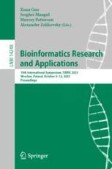Search
Search Results
-
On Sorting by Flanked Transpositions
Transposition is a well-known genome rearrangement event that switches two consecutive segments on a genome. The problem of sorting permutations by...
-

-
A 1.375-Approximation Algorithm for Sorting by Transpositions with Faster Running Time
Sorting Permutations by Transpositions is a famous problem in the Computational Biology field. This problem is NP-Hard, and the best approximation...
-
Sorting by Reversals and Transpositions with Proportion Restriction
In the field of comparative genomics, one way of comparing two genomes is through the analysis of how they distinguish themselves based on a set of...
-
Transposable element finder (TEF): finding active transposable elements from next generation sequencing data
BackgroundDetection of newly transposed events by transposable elements (TEs) from next generation sequence (NGS) data is difficult, due to their...

-
An improved approximation algorithm for the reversal and transposition distance considering gene order and intergenic sizes
BackgroundIn the comparative genomics field, one of the goals is to estimate a sequence of genetic changes capable of transforming a genome into...

-
Genome Rearrangement Analysis
Genome rearrangements are mutations that change the gene content of a genome or the arrangement of the genes on a genome. Several years of research...
-
Achieving large and distant ancestral genome inference by using an improved discrete quantum-behaved particle swarm optimization algorithm
BackgroundReconstructing ancestral genomes is one of the central problems presented in genome rearrangement analysis since finding the most likely...

-
Sorting signed circular permutations by super short operations
BackgroundOne way to estimate the evolutionary distance between two given genomes is to determine the minimum number of large-scale mutations, or geno...

-
Somatic variations led to the selection of acidic and acidless orange cultivars
Somatic variations are a major source of genetic diversification in asexual plants, and underpin clonal evolution and the breeding of asexual crops....

-
Approximation algorithm for rearrangement distances considering repeated genes and intergenic regions
The rearrangement distance is a method to compare genomes of different species. Such distance is the number of rearrangement events necessary to...

-
Super short operations on both gene order and intergenic sizes
BackgroundThe evolutionary distance between two genomes can be estimated by computing a minimum length sequence of operations, called genome...

-
Recombinations, chains and caps: resolving problems with the DCJ-indel model
One of the most fundamental problems in genome rearrangement studies is the (genomic) distance problem. It is typically formulated as finding the...

-
Gamete binning: chromosome-level and haplotype-resolved genome assembly enabled by high-throughput single-cell sequencing of gamete genomes
Generating chromosome-level, haplotype-resolved assemblies of heterozygous genomes remains challenging. To address this, we developed gamete binning,...

-
A Guide to Phylogenomic Inference
Phylogenomics aims at reconstructing the evolutionary histories of organisms taking into account whole genomes or large fractions of genomes....
-
Heuristics for Breakpoint Graph Decomposition with Applications in Genome Rearrangement Problems
The breakpoint graph of a permutation is a well-known structure used in genome rearrangement problems. Most studies use the decomposition of such...
-

-
Detecting gene breakpoints in noisy genome sequences using position-annotated colored de-Bruijn graphs
BackgroundIdentifying the locations of gene breakpoints between species of different taxonomic groups can provide useful insights into the underlying...

-
Assessment of mitochondrial genomes for heterobranch gastropod phylogenetics
BackgroundHeterobranchia is a diverse clade of marine, freshwater, and terrestrial gastropod molluscs. It includes such disparate taxa as...

-
Multiple genome alignment in the telomere-to-telomere assembly era
With the arrival of telomere-to-telomere (T2T) assemblies of the human genome comes the computational challenge of efficiently and accurately...

